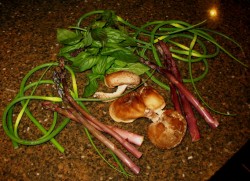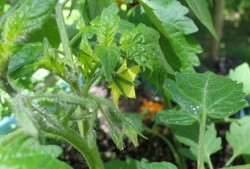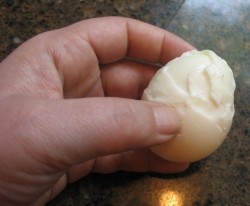The Last Local Supper?
So, this is it–the end of the 2006 Eat Local Challenge.
Does this mean that I am finished with the topic of eating locally?
Are you kidding? I mean, look at the beautiful produce I had to work with for tonight’s supper: Siam Queen Thai basil, fresh shiitake mushrooms, garlic scapes and look–is that? Could it be? Yes! It is fresh, local asparagus! The season wasn’t over after all, and look–this batch is PURPLE!
When I can get so much beautiful food, why should I ever go back to eating grocery store plastic produce? Why should I pay money for fresh vegetables and fruits that are no longer fresh, and that probably have fewer nutrients in them? Why should I eat strawberries that have been bred to be huge, bright red, hard as rocks, and smell good, but which have no discernable flavor by the time they reach Ohio?
The answer is clear and simple: I shouldn’t.
And I don’t intend to.
Yeah, I will still be buying bananas at Krogers, and some onions and potatoes now and again. Avocados are not exactly thick on the ground here in Appalachian Ohio, so I will pick some of those up, too. And if I can get my hands on properly ripe mangoes (like the luscious organic ones from the local health food store, The Farmacy I picked up last week), I’ll be all over those, as well as seasonal pomegranates.
But for every fruit and vegetable that grows here in Ohio: you can bet I will be buying those in their season, when they are at thier peak of ripeness, when they are so fresh that you can smell the earth and sun on them.
I see no reason to go back, and more importantly, my tastebuds can discern no reason to return to grocery store dependance.
So, you can look forward to more posts about eating locally, more profiles of the local food scene here in Athens, more updates on what is in season and fresh at any given time, more book reviews from The Locavore’s Bookshelf, and more recipes utilizing the bounty of the fecund farmlands that dot Athens county.
Tune in tomorrow, when I will write about what I cooked tonight with all of those lovely ingredients pictured above.
Until then, let me know what you would have made with those pretties–I am curious to see what other folks would have come up with.
Announcing the Green Blog Project
I read about this event on Mahanandi, and it sounded so good, I wanted to promote it here, too.
L.G. of Mango and Ginger is hosting this long-term food blog event, The Green Blog Project that is open to everyone. What are the rules?
All she wants you to do is grow something edible in your garden, on your patio, in a pot on your windowsill or in a greenhouse, then make a recipe featuring it, and blog about it, sometime between now and September. She will have a round-up in September, and then the whole cycle will start again, for those who grow food or herbs in the wintertime. The second round will cover from October to March, and she will post the round-up in March.
You cannot get much more local than food you have grown yourself! So there you are! I know that quite a few of our fellow food bloggers, and readers, are growing gardens, so let’s all jump in and share our garden stories and recipes with L.G.
I bet you can guess from the photograph above what my recipe will feature: fresh tomatoes. Yes, my three biggest tomato plants are loaded with blossoms, and soon will be sporting tiny hard, green fruit. In the next couple of months, they will ripen into little grape-sized globes of scarlet sweetness!
I can’t wait to taste them, and I can’t wait to see what everyone else posts about!
Great idea, L.G.! I’ll be there, with tomatoes and herbs a-plenty!
The Downside of Really Fresh, Local Eggs
You knew that there would be a downside to all of this eating local stuff, didn’t you?
And there is.
The big one I remembered this afternoon, as I was making lunch for myself was the fact that it is nearly impossible to make pretty devilled eggs from extremely fresh, pastured eggs.
As you can see from the photograph above–they turn out pockmarked, unsightly and just plain old ugly.
Trying in vain to peel the two eggs I had decided to devil for my lunch, with shaking fingers, I started to laugh, remembering my Grandma’s battles with her fresh boiled eggs, in an attempt to make devilled eggs that didn’t look like they suffered from a dread disease.
She figured out a solution, of course. If she knew she was going to make devilled eggs for a certain day, like say, the Fourth of July, she would set aside two dozen eggs a week or so in advance to age. Older eggs peel more easily, in large part, because the air pocket in the eggs grows larger. The membrane of the egg doesn’t cling as tightly, either, allowing a nimble-fingered cook to peel up a well-crackled shell by picking at a bit of membrane and zipping everything off in two or three sweeps.
But, if Grandma just happened to decide to make devilled eggs because she wanted some, well, there was no power on earth that would make those eggs look good. They always tasted great, mind you, but they never looked like anything one would find in a magazine. (I am very grateful that Martha Stewart was not big when Grandma was alive, as I suspect Grandma would have been made to feel very inadequate by all of Martha’s very decorative “good things” in her books and magazines.) She would painstakingly peel the eggs, watching bits of eggwhite cling tightly to the shell and sigh as she tossed them in the composting bucket. The resulting eggs always looked like craggy moonscapes or the skin of a smallpox survivor, and she would grit her teeth, and move on.
Sometimes, the whites would end up looking so ugly that Grandma would just throw up her hands and make egg salad instead, but usually, she just moved on and made devilled eggs as if nothing was wrong. When she’d put the platter down on the table for lunch or supper, Grandpa and Uncle John would always tease her about her “special eggs,” but it never stopped any of us from cleaning the plate up in one sitting.
So, what did I do with my ugly eggs today?
I made devilled eggs–two of them. Making two devilled eggs is really not much worth the trouble, but I had a hankering for them. So, I made them, and sat down and ate them with a butterhead lettuce salad–all local and organic–for lunch.
They were good, even if they did look disreputable.
Leftovers For Breakfast
I love juxtaposing words with opposite connotations.
Breakfast is one of the most beloved meals in any culture. Everybody loves breakfast, and waxes poetic about it. Folks declare the staples of breakfast–regardless of culture–to be the ultimates in comfort food.
Leftovers, on the other hand, get a bum rap from most people.
Fed one too many “mystery casseroles” by harried Moms that contained flotsam and jetsam from prior meals, many people have developed an attitude against leftovers of any sort. In the US, leftovers are a bit of a national joke; food writer Calvin Trillin once said, “The most remarkable thing about my mother is that for thirty years she served the family nothing but leftovers. The original meal has never been found.”
Not me. I love leftovers.
Oh, now, don’t get me wrong. I have had some wretched concatenations of leftover bits and canned pieces in my life that were only barely edible, but in general, I have to say that I love leftovers, and I have a good time eating them.
I like them so much, that I have been known to make too much of a dish, just in order to eat it warmed over in a day or two.
Lentil soup, or dal, or really, any sort of dried bean dish, whether soupy or dry, are always better after they have sat about in the fridge overnight or longer, letting the flavors all get friendly and develop. The broth of soupy beans thickens and becomes rich, refried beans just get tastier and tastier over time, and the spices in dal create a marriage so tight you can no longer pick out individual flavors.
In fact, I am of the opinion that Indian foods, in particular, are almost universally better the next day. This is why whenever I make Indian food, I always make extras, so I can enjoy them, either simply heated up, or transformed into another dish, the next day.
Witness what I had for breakfast this morning: an egg and potato hash made with about three tablespoons of leftover Aloo Methi. Aloo methi is a curry made of par-boiled potatoes cut up and fried with browned onions, garlic, chiles, ginger, spices and fenugreek greens. They are deliciously fragrant, and are so full of flavor that it is hard to believe that they started out as simple boiled potatoes. I adore them, and had made them to take to a neighborhood potluck on Saturday. Most of the little bit that was left I ate heated up in the microwave, but there were about three tablespoons of it left that I could neither throw away, nor give to the dogs to eat.
So, this morning, waking up in a fit of ravenous hunger that is characteristic of the second trimester of pregnancy (this is the time when the baby grows the most quickly–and most women can tell it, because their appetite goes into overdrive), I tottered downstairs, and ducking my head into the fridge, I spied the tiny mound of aloo methi sealed up in their wee plastic container.
There was not enough to satiate my hunger, but I was not deterred.
My Grandma, a frugal farmwife who had to make substantial breakfasts every morning, would sometimes take leftover fried potatoes, and reheat them in a pan with bacon grease. Sometimes she added flakes of leftover ham, and then, she would stir up a passel of fresh eggs, and dump them into the pan, scrambling them among the potatoes and ham. This made a one-dish breakfast she called “Egg and Potato Hash,” which I loved. She varied it, of course. Sometimes, she added sauteed onions and green peppers, and sometimes cheese or crumbled sausage. But always, the base of the dish was nothing more than cold, leftover fried potatoes from the night or so before, and farm-fresh, pastured eggs, thier yolks a rich yellow from extra beta carotene from the grass and clover the chickens ate.
“Hash” as a word, comes to the English language from the French “hacher,” meaning to chop, and so refers to a dish that is composed of bits and pieces of different foods. In American parlance, it usually refers to a sort of fried potato dish, wherein the potatoes are combined with bits of meat or other vegetables and all are cooked together in the same pan. Canned corned beef, one of my nightmare foods of childhood, often appeared in hash on my mother’s table, but leftover ham made a nice dish. Sometimes cabbage was fried in the mixture, which I did not approve of, which is not surprising, as I only liked cabbage raw.
Generally, hash is looked down upon as a low-quality dish made of poor ingredients, but I think that is not necessarily so. My Grandma’s breakfast hashes were all quite tasty, and made a nice filling start to day filled with physical labor. Stick-to-the-ribs breakfasts are necessary on a farm where the morning’s activities were endless and varied. One could be called upon to herd cattle, feed and water chickens, dig postholes, mend fences, plant potatoes, or build bean trellises. All of these activities require a good amount of energy, and if one is a skinny kid, a hearty breakfast allows one to do a great deal of work before noon without passing out.
Gestation is also hard work, though I admit, it is nowhere nearly as taxing as posthole digging. But, it does require a filling breakfast if one is to make it until noon without tearing into a snack of cat or husband.
In the interest of not consuming either a beloved cat or an innocent husband, I dragged out my very own carton of local pastured eggs, and cracked two in a bowl, and stirred them up, then heated up the skillet with a dab of butter in it. (Bacon grease I had, but I thought that it would inject a rather odd note into the proceeding, as it is not often used in Indian cookery, if it is used at all.)
The potatoes went in, and I stirred, chopped and lightly mashed them into the pan, cutting them down to smaller pieces so they would brown a bit and heat faster. Smaller potato bits also incorporate better into the eggs.
This I did on medium heat, and once the potatoes were sizzling and steamy hot, I gathered them into a pile and poured the eggs over them, immediately stirring them like mad. Most of the time I scramble my eggs on low heat, so that they are all delicate and custardy-soft, but with potatoes in the midst, I wanted them to be cooked faster, and a bit harder.
The eggs solidified rapidly, melding their saffron-colored yolks to the turmeric-tinged potatoes perfectly. All told, I think the dish took about five minutes to cook, and as I turned it out into a bowl, the incomparable scent of fenugreek, ginger and onions mingled with the deep eggy richness to create a tantalizing aroma that had my mouth watering instantly.
It was a perfect breakfast.
Filling, fast, and for the most part, from local ingredients. The only non-locally sourced ingredients were the spices, the ginger and the dried methi leaves. The potatoes, onions, garlic, chiles, eggs and fresh fenugreek greens, were all locally grown and produced.
It tasted divine, it stopped the hunger-beast from twisting my mood into utter despair, and it was pretty darned healthy, too.
You can’t beat that.
Garden Woes, Garden Grows
This has been a weird month of May.
Last week, and part of the week before, we had a lot of rain and low temperatures–down to the forties and fifties some days and nights. We even had frost warnings and nights that the temperatures dropped down to the thirties.
Needless to say, this has affected farmers and gardeners.
As far as farmers go–it seems that I was premature in declaring asparagus to be done for the year–a new crop of shoots were in evidence yesterday at the Farmer’s Market, including purple spears! Needless to say, I picked some up, and brought them home, along with other interesting comestibles. But the strawberries have been slowed down a great deal by the cold and rain; for the next five days, our farmers tell us, there will be very few strawberries to speak of. After that, however, production will go back to its formerly fecund level. (And, maybe, then, we can quit just rinsing them and eating them out of hand and actually make some shortcake, or bread pudding or pie or somesuch. I just haven’t gotten around to it yet–they are so good plain!)
I am sad to report that most of my basil, despite my best efforts at keeping it happy and healthy, have succumbed to the cold and damp conditions. Half of them died outright, and the others which have shown a slight tendency to rally in the heat of the past couple of days (yesterday in the low eighties, today in the upper eighties and tomorrow in the nineties), I have taken out of the self-watering planter, and transplanted into pots with better drainage. Here, I hope to nurse them along, back to health, but I don’t have much hope for them. Fully half the root systems of each plant have rotted away in the chilly, wet soil in which they were planted, and their vascular systems seem weak and flabby. I would not be surprised to see them infested with some sort of insect next, at which point, I will pull them up and call them a complete loss.
So, I replaced the basils, and now I have a mixture of both Siam Queen and Genovese basils in a classical-looking urn planter. I crowded them in together, as I have found that basils really don’t mind this treatement at all, and will grow up and out, tangling their stems together with mad abandon.
The once-full basil planter is now the home of two more tomato plants; for whatever reason, the recent oddly chill weather has not affected my current grape tomatoes. The hardy plants are flowering with great glee and are scheduled to be staked tomorrow–they are tall enough to need support already. I treated them no differently than the basils–I simply made certain that they had cover on the frost nights, and they were perfectly happy when I uncovered them each morning, while the basils looked more and more puny and sickly.
I also planted my last self-watering planter with a combination of different sorts of sage, tarragon, rosemary, Greek columnar basil, Greek oregano, and just this afternoon, too lush dill plants that I got at a bargain price. This should conclude my culinary herbal plantings, with the exception of me sowing some more fenugreek seeds. The first ones suffered from the cold, so I am trying again.
The flowers are all gorgeous, and I am thrilled with how well even the more cold-sensitive plants like the lantana have survived the chilly, drippy weather.
Our lovely shade bed, however, is slated to be completely dug up sometime in the summer. The people who put in the hot tub next to our house, left a pile of mud that drains down the slope into our driveway every time it rains. In addition, it turns out that the people who built the house put no drainage for water as it comes off the slope where the house sits, so it just runs off into our driveway.
This causes unsightly soil erosion, and makes it difficult to grow anything closer to the house, under the deck, near the garage, because the dirt just washes away.
So, the contractors are going to put in a retaining wall to hold back the soil near the hot tub, and pave around that end of the hot tub, and then, they are going to put in drainage, all down the slope, which includes where the shade garden is installed. After the drainage is in, they are going to put stone up on the slope, and form planting pockets where we can extend the shade bed with a planting of ostrich ferns and hostas.
I am told by our neighbors and by a friend who is a garden designer, that our landscaping contractor works very neatly and is very, very good with caring for plants in existing borders and beds, so that no harm will come to them while he is putting in drainage.
That is a load off my mind.
So, while it will be a bit of a trial to have to watch all of the plants we have worked so hard on coming out of the ground so soon–they will be reinstalled (while they are digging out dirt, I am going to have them amend the soil as it goes back–it is rocky subsoil clay primarily, and so I see no reason not to add huge amounts of organic matter–compost, manure, and peat moss–to help lighten the soil and add to its fertility.
While the contractor was there–we had him look at our back yard, with its slope. He has figured a way to get the equipment back there that is required to do the terracing that will turn that lawn into magnificent, useable garden space. He was thrilled to see it–all of that space, with so much sun–he said it was like discovering a hidden treasure. He has done a lot of work in our neighborhood and never known that our land was there, so he is excited with the idea of starting work on it next spring.
So that is the good and the bad of our gardening. You lose some plants, you gain others, and life continues on.
In this case, I think that the good definately outweighs the bad; our garden is alive with plants, flowers, birds and insects, and I cannot ask for more than that.
Stay tuned tomorrow for an update on the local produce and another recipe featuring the goodies I found at the Farmer’s Market this week.
Powered by WordPress. Graphics by Zak Kramer.
Design update by Daniel Trout.
Entries and comments feeds.










